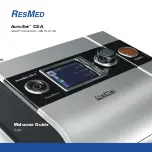
19
2) Place the patient's elbow in a 90° flexion position.
3) Apply the orthosis laterally on the forearm.
4) Position the supports of the orthosis between the wrist joint (see fig. 2) and approx. 2 cm from
the olecranon (see fig. 3).
INFORMATION: The distal support has to be applied on the
ulnar head. In case of patient-specific pressure sensitivity at this point, the support
can be applied directly before it. Ensure that the edge of the distal forearm support
does not press on the back of the hand.
5) Mark the length adjustment on the bar.
6) Take off the orthosis and tighten the screws with the wrench (torque value:
1 Nm
) (see fig. 4).
Adapting the orthosis angle
The angle adjustment range is
30°
max. in palmar flexion or dorsiflexion, with one position
respectively corresponding to
10°
. The positions are marked by holes in the orthosis joint.
1) Loosen the screw on the orthosis joint with the wrench (see fig. 7).
2) Place the patient's elbow in a 90° flexion position.
3) Apply the orthosis laterally on the forearm and align it.
4) Set the orthosis joint to the desired angle.
5) Mark the angle position.
6) Remove the orthosis and tighten the screw with the wrench (torque value:
3.6 Nm
).
Adapting the hand support bar
1)
INFORMATION: Align the hand support bar with the curve facing up.
Insert the hand support bar (see fig. 1, item 3) into the orthosis (see fig. 8).
2) Place the patient's elbow in a 90° flexion position.
3) Apply the orthosis laterally on the forearm.
4) Slide the hand support bar and position it under the palm according to the individual condi
tions.
5) Take off the orthosis and tighten the screw with the wrench (torque value:
1 Nm
).
Adapting the forearm supports
1) Place the patient's elbow in a 90° flexion position.
2) Apply the orthosis laterally on the forearm.
3) Mark the required lengths of the supports (see fig. 5).
4) Trim the supports with scissors (see fig. 6).
5) Sand the cut edges smooth.
6) Check the fit of the orthosis again and rework it as needed.
Adapting the forearm pad
>
Prerequisite:
Take off the orthosis.
1) Apply the self-adhesive hook-and-loop patches to the inside of the supports (see fig. 9).
2) Position the pads inside the supports according to their shape and fasten with hook-and-loop.
3) Individually trim the pads with scissors, leaving a
5 mm
overhang along the edges of the sup
ports (see fig. 10).
Adapting the forearm straps
The forearm straps are attached in the integrated slots in the supports. With correct assembly,
the pull loop of the strap has to be on top.
1) Pull the strap through the lower slot in the support and fasten it with the hook-and-loop clos
ure.
2) Pull the strap through the upper slot in the support and fasten it at the hook-and-loop closure,
individually adapting the strap circumference to the arm.
Adapting the pad of the padded strap for the hand support bar
>
Prerequisite:
Take off the orthosis.
1) Open the padded strap (see fig. 1, item 5).
Summary of Contents for 28P31
Page 2: ...28P30 1 2 3 4 5 2...
Page 3: ...6 7 8 9 10 11 3...
Page 4: ...12 13 14 15 16 17 4...
Page 5: ...28P31 18 19 20 21 22 5...
Page 6: ...23 24 25 26 27 28 6...
Page 7: ...29 30 31 32 33 34 7...
Page 8: ...35 36 37 38 39 40 8...
Page 9: ...41 42 43 Material PP PA PA EL PU Aluminium 30 9...
Page 103: ...103 3 4 Manu Neurexa plus 28P30 28P31 Omo Neurexa plus 5065N 4 4 1 4 2...
Page 104: ...104 5 5 1 5 2 1 1 4 1 1 2 90 3 4 2 2 3 5 6 1 4...
Page 110: ...110 4 2 1 5 1 5 1...
Page 116: ...116 5 5 1 5 2 1 1 4 1 1 2 90 3 4 2 2cm 3 5 6 1 Nm 4 30 10 1 7...
Page 119: ...119 6 1 2 3 4 30 C 5 6 1 2 7 8 8 1 8 2 CE 93 42 EWG IX I VII...
















































